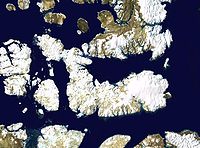Canadian Wilderness
The wilderness of Canada can be found outside its major cities and towns.
Animals Found There
[edit | edit source]There are many animals in the Canadian Wilderness. Some are:
- ruffed grouse
- moose
- black bears
- snowshoe rabbits
and
- striped skunks
Cirque Glaciers
[edit | edit source]

Cirques, as diagrammed at the left, are formed by a glacier (the cirque glacier) and usually exhibit a Bergschrund, randkluft and the headwall gap. The image at the right shows a glacier on Baffin Island that has retreated back to a cirque glacier.
Labrador
[edit | edit source]

The Torngat Mountains have nominal coordinates of 59°25′N 64°30′W.
Yukon
[edit | edit source]


Two or more glaciers as in the image on the left and second right make the Kluane icefield. Mount Logan has a location at 60°34'02"N 140°24'10"W.
Mount Vancouver is at 60.3361°N 139.6947°W.
Keele Peak has coordinates 63°25′53″N 130°19′26″W.



The ice on the young basaltic cinder cone in the image on the right is a glacier. The young cinder cone is on the flanks of Mount Edziza. Mount Edziza is located at 57°42'58"N 130°38'02"W.
Mount Silverthrone is located at 51°31'41.9"N 126°06'47.9"W.
Ha-Iltzuk Icefield has a nominal location at 51°25'N 125°55'W.
"The Heiltskuk (also written Ha-Iltzuk) Icefield covers an area of approximately 3,600 square kilometers (1,389 square miles) in the southern Coast Mountains of British Columbia. This detailed astronaut photograph illustrates the icefield—mostly covered by snow across the upper mountain slopes—and two major valley glaciers that extend from it. Valley glaciers are large masses of slowly flowing ice and entrained debris that move downhill, carving out wide U-shaped valleys in the process. The locations of former valley glaciers can frequently be identified by the presence of these U-shaped valleys on a now glacier-free landscape."[1]
"The two largest valley glaciers in the image, Silverthrone Glacier and Klinaklini Glacier, both flow towards Knight Inlet to the south (not shown). Several moraines—accumulations of rock and soil debris along the edges and surface of a glacier—are drawn out into long, dark lines by the flowing ice, and they extend along the length of both glaciers. The confluence of the two glaciers at image center illustrates how a moraine located along the side of a glacier can become a medial moraine, in the center of the joined ice mass. Smaller valley glaciers are visible near Mount Silverthrone""[1]
Mount Robson in British Columbia has coordinates 53.1106°N 119.1564°W.
Alberta
[edit | edit source]


Mount Columbia has coordinates 52°08′50″N 117°26′30″W.
Mount Hector is at 51°34′24″N 116°15′30″W in Banff National Park, Canada.
Mount Temple is located at 51.3506°N 116.2067°W.
Mount Joffre has coordinates 50°31′40″N 115°12′30″W.
Victoria Island
[edit | edit source]Victoria Island is at 71°N 110°W.
Bathurst Island
[edit | edit source]
Bathurst Island is located at 75°46'N 99°47'W.
Devon Island
[edit | edit source]
The Devon Ice Cap is on eastern Devon Island, Nunavut, Canada, at 75°20′52″N 82°10′26″W.
The Treuter Mountains (75°42′N 82°30′W are on eastern Devon Island, Nunavut, Canada. They are part of the Devon Ice Cap.
Ellesmere Island
[edit | edit source]

Ellesmere Island is located at 79°50'N 78°W.
The Agassiz Ice Cap is located at 80°30'N 75°W.
Baffin Island
[edit | edit source]




Baffin Island has a nominal position of 69°N 72°W.
The Penny Ice Cap has a nominal position at 67°15'N 66°W.
References
[edit | edit source]- ↑ 1.0 1.1 William L. Stefanov (31 August 2009). "Heiltskuk Icefield, British Columbia". Washington,DC USA: NASA. Retrieved 2014-11-14.
